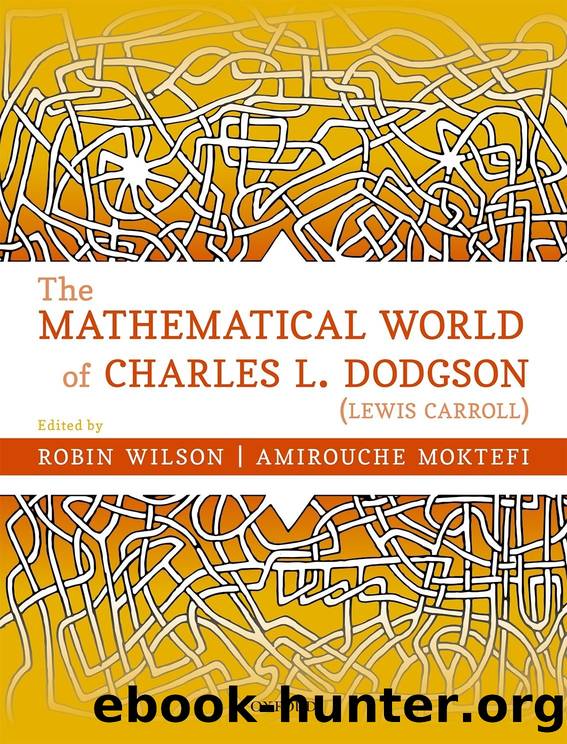The Mathematical World of Charles L. Dodgson (Lewis Carroll) by Wilson Robin;Moktefi Amirouche; & Amirouche Moktefi

Author:Wilson, Robin;Moktefi, Amirouche; & Amirouche Moktefi [Wilson, Robin & Moktefi, Amirouche]
Language: eng
Format: epub
ISBN: 9780198817000
Publisher: OxfordUP
Published: 2019-02-09T00:00:00+00:00
Using puzzles and games to entertain
Puzzles and games continued throughout Dodgsonâs life, mainly as a form of entertainment to amuse himself, his colleagues, and his friends. One of his earliest games, created in 1855 when he was 23 years old and mentioned in his Diaries, was âWays and Meansâ.1 This was a card game based on auctions and requiring buying and selling using counters, and is principally a word game involving strategy. Dodgson played it with his siblings and visitors: it still exists, but it has never been published.
As we saw in Chapter 1, soon after Dodgson took on the role of Lecturer in Mathematics at Christ Church, he offered to teach âsumsâ at St. Aldateâs elementary school, just opposite Tom Gate in Oxford. All began well with the first few lessons undertaken in January 1856, but soon Dodgson was describing the lessons as ânoisyâ and âunmanageable.â He resorted to a few mathematical tricks to gain the attention of the pupils.2 On 5 February he tried the puzzle
of writing the answer to an addition sum, when only one of the five rows has been written: this, and the trick of counting alternately up to 100, neither putting on more than 10 to the number last named, astonished them not a little.
Then on 8 February he showed them âthe â9â trick of striking out a figure, after subtracting a number from its reverseâ, a well-known puzzle that can be traced back to the Middle Ages. These three puzzles, and their explanations, are described in more detail here; none of them was invented by Dodgson.
Such mathematical âtricksâ did not succeed in gaining the pupilsâ attention in the long term. Dodgson gave up the experiment by the end of February, and never again offered to teach mathematics to young school pupils. However, for the rest of his life the use of mathematical puzzles became a feature of his entertainment when engaging with small groups of young and old. Dodgson was frequently invited to visit the families of his friends and acquaintances, not just his colleagues at the University, and it became a feature of these visits that puzzles, games, and story-telling were on the agenda, continuing an activity that he had established with his own siblings.
Download
This site does not store any files on its server. We only index and link to content provided by other sites. Please contact the content providers to delete copyright contents if any and email us, we'll remove relevant links or contents immediately.
| Algebraic Geometry | Analytic Geometry |
| Differential Geometry | Non-Euclidean Geometries |
| Topology |
Modelling of Convective Heat and Mass Transfer in Rotating Flows by Igor V. Shevchuk(6345)
Weapons of Math Destruction by Cathy O'Neil(6069)
Factfulness: Ten Reasons We're Wrong About the World – and Why Things Are Better Than You Think by Hans Rosling(4611)
Descartes' Error by Antonio Damasio(3181)
A Mind For Numbers: How to Excel at Math and Science (Even If You Flunked Algebra) by Barbara Oakley(3173)
Factfulness_Ten Reasons We're Wrong About the World_and Why Things Are Better Than You Think by Hans Rosling(3152)
TCP IP by Todd Lammle(3089)
Applied Predictive Modeling by Max Kuhn & Kjell Johnson(2970)
Fooled by Randomness: The Hidden Role of Chance in Life and in the Markets by Nassim Nicholas Taleb(2959)
The Tyranny of Metrics by Jerry Z. Muller(2946)
The Book of Numbers by Peter Bentley(2865)
The Great Unknown by Marcus du Sautoy(2605)
Once Upon an Algorithm by Martin Erwig(2533)
Easy Algebra Step-by-Step by Sandra Luna McCune(2530)
Lady Luck by Kristen Ashley(2490)
Practical Guide To Principal Component Methods in R (Multivariate Analysis Book 2) by Alboukadel Kassambara(2441)
Police Exams Prep 2018-2019 by Kaplan Test Prep(2435)
All Things Reconsidered by Bill Thompson III(2320)
Linear Time-Invariant Systems, Behaviors and Modules by Ulrich Oberst & Martin Scheicher & Ingrid Scheicher(2298)
